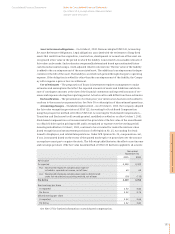Siemens 2005 Annual Report Download - page 152
Download and view the complete annual report
Please find page 152 of the 2005 Siemens annual report below. You can navigate through the pages in the report by either clicking on the pages listed below, or by using the keyword search tool below to find specific information within the annual report.
152
On December 8, 2003, the Medicare Prescription Drug, Improvement and Modernization Act
of 2003 (the Act) was signed into law in the U.S. The Act introduces a prescription drug benefit
under Medicare (Medicare Part D), as well as a federal subsidy to sponsors of retiree health care
benefit plans that provide a benefit that is at least actuarially equivalent to Medicare Part D. In
accordance with FASB Staff Position (FSP) FAS 106-1, management elected to defer any accounting
for the effects of the Act on the plan in interim periods preceding the fourth quarter of fiscal
2004. In May 2004, FSP FAS 106-2 was issued effective for interim periods beginning after June 15,
2004. FSP FAS 106-2 supersedes FSP FAS 106-1 and provides authoritative guidance on accounting
for the federal subsidy prescribed by the Act. Pursuant to FSP FAS 106-2 and the issuance of fur-
ther guidance from the Center of Medicare and Medicaid on July 26, 2004, management has con-
cluded that Siemens’ U.S. health care plans are at least actuarially equivalent to Medicare Part D.
Following the prospective application method prescribed by FSP FAS 106-2, Siemens has remeas-
ured Siemens’ U.S. postretirement obligation as of July 1, 2004. This remeasurement reduced
Siemens’ Accumulated Postretirement Benefit Obligation (APBO) by €49 and increased the unrec-
ognized gain component by the same amount. The impact of this remeasurement will be amor-
tized over the average working life of Siemens’ U.S. employees eligible for postretirement bene-
fits beginning October 1, 2004. The effect of the Act on the foreign net periodic benefit costs as of
September 30, 2004 is not considered significant.
In January 2003, the Financial Accounting Standards Board (FASB) issued FASB Interpretation
(FIN) 46, Consolidation of Variable Interest Entities, and replaced it by issuing FIN46(R) in
December 2003. FIN 46R interprets Accounting Research Bulletin (ARB) 51, Consolidated Financial
Statements and clarifies the consolidation of certain entities (VIE’s) for which either a) the equity
investment at risk is not sufficient to permit the entity to finance its activities without additional
subordinated financial support or b) the equity investors lack an essential characteristic of a con-
trolling financial interest or c) investors economic interests don’t equal attached voting rights
and the VIE activities involve or are conducted for an investor with disproportionately small vot-
ing rights. FIN 46R requires the primary beneficiary of VIE’s and the holder of a significant vari-
able interest in VIE’s to disclose certain information relating to their involvement with the VIE’s.
FIN 46R was adopted by the Company as of March 31, 2004. The Company holds variable interests
in various VIE’s, which are not significant either individually or in the aggregate. The adoption of
FIN 46R did not have a material impact on the Company’s Consolidated Financial Statements.
On October 1, 2002, the Company adopted SFAS 144, Accounting for the Impairment or Dispos-
al of Long-Lived Assets, which supersedes SFAS 121, Accounting for the Impairment of Long-Lived
Assets and for Long-Lived Assets to Be Disposed Of, and the accounting and reporting provisions
of APB Opinion 30, Reporting the Results of Operations – Reporting the Effects of Disposal of a
Segment of a Business, and Extraordinary, Unusual and Infrequently Occurring Events and
Transactions, for the disposal of a segment of a business. This statement establishes a single
accounting model based on SFAS 121 for long-lived assets to be disposed of by sale, including dis-
continued operations. Major changes include additional criteria for long-lived assets to qualify as
“held for sale” and the requirement that long-lived assets to be disposed of other than by sale be
classified as held and used until the disposal transaction occurs. SFAS 144 expands discontinued
operations reporting to include a component of an entity (rather than only a segment of a busi-
ness) that either has been disposed of or is classified as held for sale. SFAS 144 retains the current
requirement to separately report discontinued operations. Discontinued operations are reported
when a component of an entity comprising operations and cash flows that can be clearly distin-
guished, operationally and for financial reporting purposes, from the rest of the entity and which
Management’s discussion and analysis
























